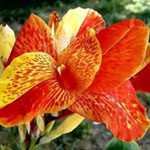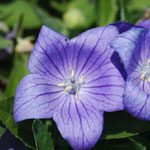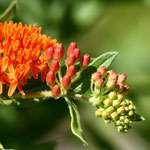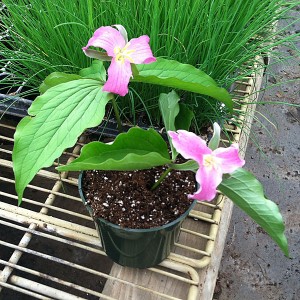Hello gardeners! We hope your winter planning season went well. (you have been planning your spring garden, haven’t you?) More now than ever, it is important for you to be food independent, and as a result we’ll have a bumper supply of seedlings available. Please call for availability though as weather during the next few weeks may affect the supply. IMPORTANT NOTICE! Every Saturday, starting April 31, 10am-2pm, I will be set up at Roscoes, 94 Green River Rd, Zirconia. Click HERE for a map.
We plan to expand our line by offering the following flowers and flowing bushes!
Perennial Hibiscus
The hardy forms of hibiscus are valued for their showy late-summer display of enormous satiny blooms. These flower best in areas with long, hot summers. Plants form an upright, bushy mound well suited to the back of a perennial border. This hybrid selection has huge brilliant red blossoms on a tall, bushy plant. Will tolerate average to wet conditions in full sun. Dies back completely to the ground in winter, but new growth is slow to appear in spring, be patient!
Canna Lily
Cannas are vibrant tender perennials that produce bold leaves and showy flowers in shades of red, orange, yellows and pinks. It is a useful summer bedding plant for both containers and borders. The flowers appear in clusters atop stiff upright stems and attract hummingbirds.
Butterfly Bush
 Drenching the air with a fruity scent, butterfly bush’s flower spikes are an irresistible lure to butterflies and hummingbirds all summer long. The plants have an arching habit that’s appealing especially as a background in informal flower borders. In warmer climates, butterfly bushes soon grow into trees and develop rugged trunks that peel.
Drenching the air with a fruity scent, butterfly bush’s flower spikes are an irresistible lure to butterflies and hummingbirds all summer long. The plants have an arching habit that’s appealing especially as a background in informal flower borders. In warmer climates, butterfly bushes soon grow into trees and develop rugged trunks that peel.
Balloon Flower (3 color)
 Dazzling flowers attract hummingbirds to your garden. Make a lovely display along walkways or in rock gardens, planted with gray foliages and bright or pastel flowers. Remove faded flowers for best reblooming. New growth emerges late in spring.
Dazzling flowers attract hummingbirds to your garden. Make a lovely display along walkways or in rock gardens, planted with gray foliages and bright or pastel flowers. Remove faded flowers for best reblooming. New growth emerges late in spring.
Echinacea (3 color)
Echinacea is a genus, or group of herbaceous flowering plants in the daisy family. The Echinacea genus has nine species, which are commonly called purple coneflowers. They are found only in eastern and central North America, where they are found growing in moist to dry prairies and open wooded areas. They have large, showy heads of composite flowers, blooming from early to late summer.
Butterfly Weed

Asclepias tuberosa is a species of milkweed native to eastern North America. It is a perennial plant growing to 1 ft – 3 ft tall, with clustered orange or yellow flowers from early summer to early fall. This plant favors dry, sand or gravel soil, but has also been reported on stream margins. It requires full sun.
It is commonly known as Butterfly Weed because of the butterflies that are attracted to the plant by its color and its copious production of nectar. It is also the larval food plant of the Queen and Monarch butterflies. Hummingbirds, bees and other insects are also attracted.
San Carlos Festival
Masses of red-violet flowers bloom amid the silvery green foliage of Salvia microphylla ‘San Carlos Festival’. The densely branched foliage features oval leaves that are fragrant, textured and slightly ruffled. This Mountain Sage is an herbaceous perennial in cooler areas and a shrub in warmer zones.
Mountain Sages are drought resistant, but respond well to regular watering. It is adaptable to many soil types, but needs good drainage. Although well adapted to dry gardens, it appreciates regular watering.
Richard can be found at area farmers markets and produce stands where they will be happy to help you get the most out of your home garden. Check our schedule HERE
We’ve dug from our cultivated wildflower collection, NATIVE TRILLIUM:
$8 per quart container
Please call ahead as these are in high demand and short supply!
Trillium catesbaei
Catesby’s Trillium
Trillium catesbaei, also known as bashful wakerobin or rosy wake-robin, is a spring flowering perennial plant found in the southeastern United States. Like most trilliums, it prefers moist, humus-rich soil in shade. Its northern limit includes the Great Smoky Mountains and other parts of North Carolina and Tennessee. Most of its populations are in the Piedmont from North Carolina to Alabama, under deciduous trees such as American beech, various oak and hickory species, and tulip poplar. Its southernmost natural occurrence is in Early County, Georgia.
Native/Alien: |
Native |
|---|---|
Type: |
Perennial |
Bloom Color(s): |
Pink, White |
Size in Feet: |
1.5 |
Light: |
Shade, Part Shade |
Soil Moisture: |
Mesic(*) |
Bloom Time: |
Mar – June |
Bloom Area: |
Mountains, Piedmont |

